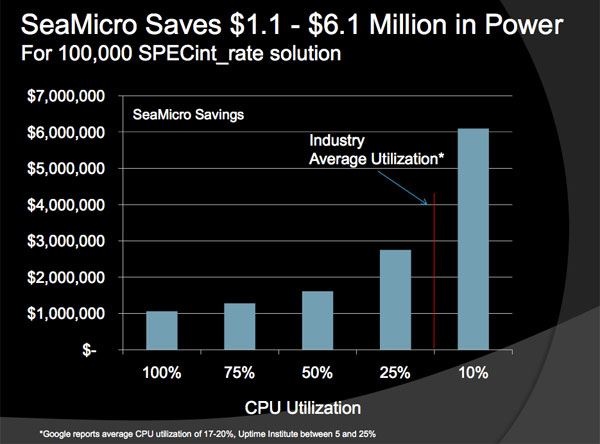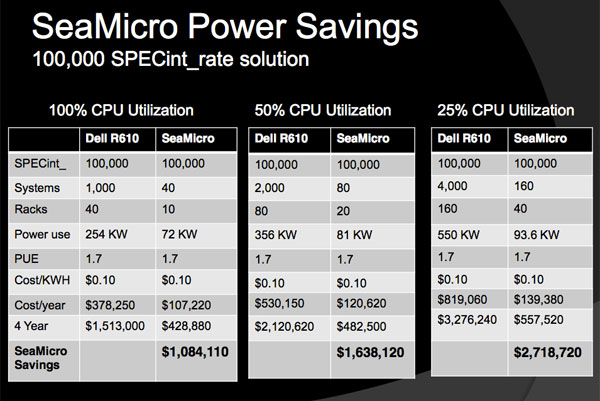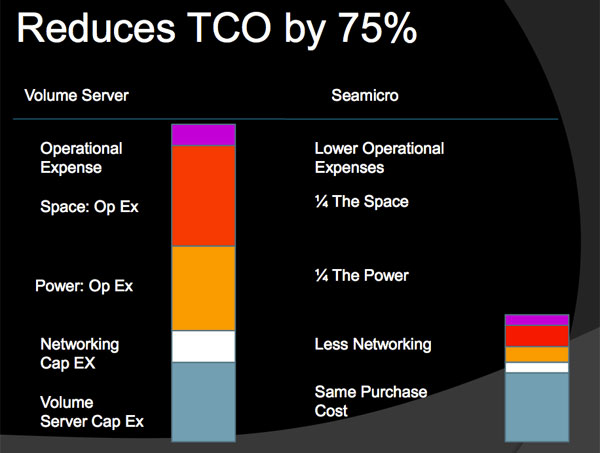SeaMicro Announces SM10000 Server with 512 Atom CPUs and Low Power Consumption
by Anand Lal Shimpi on June 14, 2010 1:38 PM EST- Posted in
- IT Computing
- CPUs
- SeaMicro
Final Words
The base configuration of the SeaMicro SM10000 comes with 512 Atom servers, 1TB of DDR2 memory and no storage. SeaMicro charges $139,000 per SM10000 in this configuration.
It is easy to see how this technology might scale. Simple drop the number of cards used in the server and now you have a lower end configuration. SeaMicro needs to be able to make enough revenue to support its business model so I wouldn’t expect any ultra cheap Atom servers out of the company anytime soon. Scaling down appears to be a top priority, although scaling up is also a possibility.
The limitations are of course numerous. There’s no official Windows support, so this for Linux only deployment. Each server is limited in performance not only by the CPU but also by the memory capacity (2GB). There’s no ECC, no real RAID support (other than striping). It’s very clear that the SM10000 can potentially serve one specific niche very well: a setup with tons of servers that have low CPU usage requirements.
The benefits are clear. If you’re running tons of servers that are mostly idle, the SM10000 could save you boatloads on power. By stripping out most of the components on the motherboard and simplifying each server down to something that consumes roughly 4W of power, SeaMicro does have a very valid solution to the power problem in data centers.

The power savings scale up tremendously. On a large scale the cost of running servers really boils down to hardware, then software then power in order of increasing cost. If you’re running tens of thousands of servers, power consumption becomes a real problem. And this is where SeaMicro is most effective:

I suspect that anyone faced with rising data center power costs will be at least interested in what SeaMicro has to offer.
The obvious argument against the SeaMicro approach is virtualization. Combine multiple servers into one beefy Xeon or Opteron machine and then you start to use those processors at their peak efficiency by keeping them loaded most of the time.

It’s difficult to tell based on a press presentation how well the SeaMicro solution fares against a beefy Xeon server running hundreds of VMs. I don’t doubt that it is a lower power solution, the question is whether or not the performance characteristics work with your specific needs.
From where I stand, the SM10000 looks like the type of product that if you could benefit from having it, you’ve been waiting for something like it. In other words, you will have been asking for something like the SM10000 for quite a while already. SeaMicro is simply granting your wish.










53 Comments
View All Comments
Shining Arcanine - Monday, June 14, 2010 - link
They should have used ARM processors for this server. Theoretically speaking, this server has only 1.6 teraflops of computing power while an ARM server using the 4-core Cortex A9 the would have 8 teraflops of computing power, while using less electricity.I cannot see why they would want to use Intel processors for this, especially when Intel charges a premium, while ARM does not.
Shining Arcanine - Monday, June 14, 2010 - link
I forgot to mention, using ARM Cortex A9 processors would enable SeaMicro to use ECC memory on these systems.loknar28 - Monday, June 14, 2010 - link
Will the ARM Processor run server software designed for the x86 architecture? Wouldn't the server OS have to be ported over to the new architecture? I am guessing that and cost reasons might be why they used the Atom. Plus Intel probably took them out to lunch.sprockkets - Monday, June 14, 2010 - link
Linux works well in ARM. Just recompile the kernel.rs1 - Monday, June 14, 2010 - link
The kernel, and every single application that you want your server to run. Not worth it.TeXWiller - Monday, June 14, 2010 - link
You would probably do it anyway if you could, so why not? This is definitely not a server for Oracle or SAP.Souka - Wednesday, June 16, 2010 - link
Cost of ARM + board over Atom + board?Maybe Atom's were used to keep cost and thermal load down?
Taft12 - Tuesday, June 15, 2010 - link
OK lets do a quick Linux/ARM compatibility check:Apache, check
PHP, check
MySQL or PostgreSQL, check
JVM, check
This stack alone is the baseline of what you would need for many of the workloads customers that would consider this hardware need. I would not be at all surprised to see something similar from this or another vendor on ARM.
yyrkoon - Tuesday, June 15, 2010 - link
Compatibility is much greater than that. Debian can/will run on ARM. Many flavors of Linux will. Now I have not checked, but I would think that would include every APT get-able application.Besides all that, *even if* You had to compile your kernel, and all needed applications/drivers etc, it would only have to be done once. Not once for every single core . . . and this is actually a preferred method for many system admins anyways. More secure, and stable that way.
The only thing that I can see an issue with, is those "admins" out there unwilling to break away from Microsoft in the server arena. Use the right tool, for the right job. This has nothing to do with what makes a better OS. They are all tools, meant to be used for the correct job.
Now I have to say something aside from all this ARM / Atom conversation. *THIS* is all we need. This gives ISPs every where another reason to be slow . . .
Shining Arcanine - Tuesday, June 15, 2010 - link
Gentoo Linux also supports ARM.